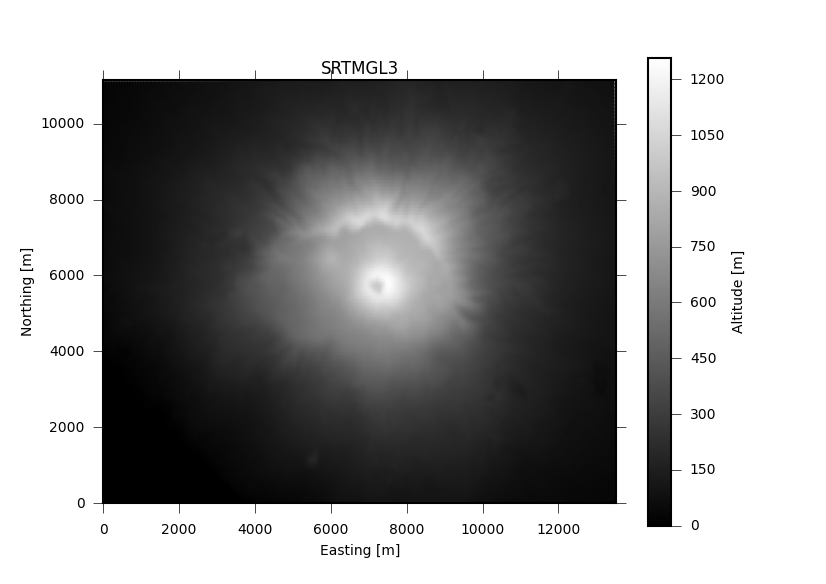Geographical datasets¶
Pyrocko offers access to commonly used geographical datasets, such as
Topography¶
The pyrocko.dataset.topo subpackage offers quick access to some
popular global topography datasets.
The following example draws gridded topography for Mount Vesuvius from SRTMGL3 ([1], [2], [3], [4]) in local cartesian coordinates.
import numpy as num
from pyrocko import plot, orthodrome as od
from pyrocko.dataset import topo
lon_min, lon_max, lat_min, lat_max = 14.34, 14.50, 40.77, 40.87
dem_name = 'SRTMGL3'
# extract gridded topography (possibly downloading first)
tile = topo.get(dem_name, (lon_min, lon_max, lat_min, lat_max))
# geographic to local cartesian coordinates
lons = tile.x()
lats = tile.y()
lons2 = num.tile(lons, lats.size)
lats2 = num.repeat(lats, lons.size)
norths, easts = od.latlon_to_ne_numpy(lats[0], lons[0], lats2, lons2)
norths = norths.reshape((lats.size, lons.size))
easts = easts.reshape((lats.size, lons.size))
# plot it
plt = plot.mpl_init(fontsize=10.)
fig = plt.figure(figsize=plot.mpl_papersize('a5', 'landscape'))
axes = fig.add_subplot(1, 1, 1, aspect=1.0)
cbar = axes.pcolormesh(easts, norths, tile.data,
cmap='gray', shading='gouraud')
fig.colorbar(cbar).set_label('Altitude [m]')
axes.set_title(dem_name)
axes.set_xlim(easts.min(), easts.max())
axes.set_ylim(norths.min(), norths.max())
axes.set_xlabel('Easting [m]')
axes.set_ylabel('Northing [m]')
fig.savefig('topo_example.png')

Footnotes
GSHHG coastal database¶
The GSHHG database is a high-resolution geography data set. We implement functions to extract coordinates of landmasks.
- Classes covered in this example:
-
import numpy as num from pyrocko.dataset.gshhg import GSHHG from matplotlib import pyplot as plt gshhg = GSHHG.intermediate() # gshhg = GSHHG.full() # gshhg = GSHHG.low() gshhg.is_point_on_land(lat=32.1, lon=44.2) # Create a landmask for a regular grid lats = num.linspace(30., 50., 500) lons = num.linspace(2., 10., 500) lon_grid, lat_grid = num.meshgrid(lons, lats) coordinates = num.array([lat_grid.ravel(), lon_grid.ravel()]).T land_mask = gshhg.get_land_mask(coordinates).reshape(*lat_grid.shape) plt.pcolormesh(lons, lats, land_mask, cmap='Greys', shading='nearest') plt.show()
Download gshhg_example.py
Footnotes
Wessel, P., and W. H. F. Smith, A Global Self-consistent, Hierarchical, High-resolution Shoreline Database, J. Geophys. Res., 101, #B4, pp. 8741-8743, 1996.
Tectonic plates and boundaries (PB2003)¶
An updated digital model of plate boundaries [6] offers a global set of present plate boundaries on the Earth. This database used in pyrocko.plot.automap.
- Classes covered in this example:
-
from pyrocko.dataset.tectonics import PeterBird2003 poi_lat = 12.4 poi_lon = 133.5 PB = PeterBird2003() plates = PB.get_plates() for plate in plates: if plate.contains_point((poi_lat, poi_lon)): print(plate.name) print(PB.full_name(plate.name)) ''' >>> PS >>> Philippine Sea Plate '''
Download tectonics_example.py
Footnotes
Bird, Peter. “An updated digital model of plate boundaries.” Geochemistry, Geophysics, Geosystems 4.3 (2003).
Global strain rate (GSRM1)¶
Access to the global strain rate data set from Kreemer et al. (2003) [7].
- Classes to be covered in this example:
Warning
To be documented by example!
Footnotes
Kreemer, C., W.E. Holt, and A.J. Haines, “An integrated global model of present-day plate motions and plate boundary deformation”, Geophys. J. Int., 154, 8-34, 2003.